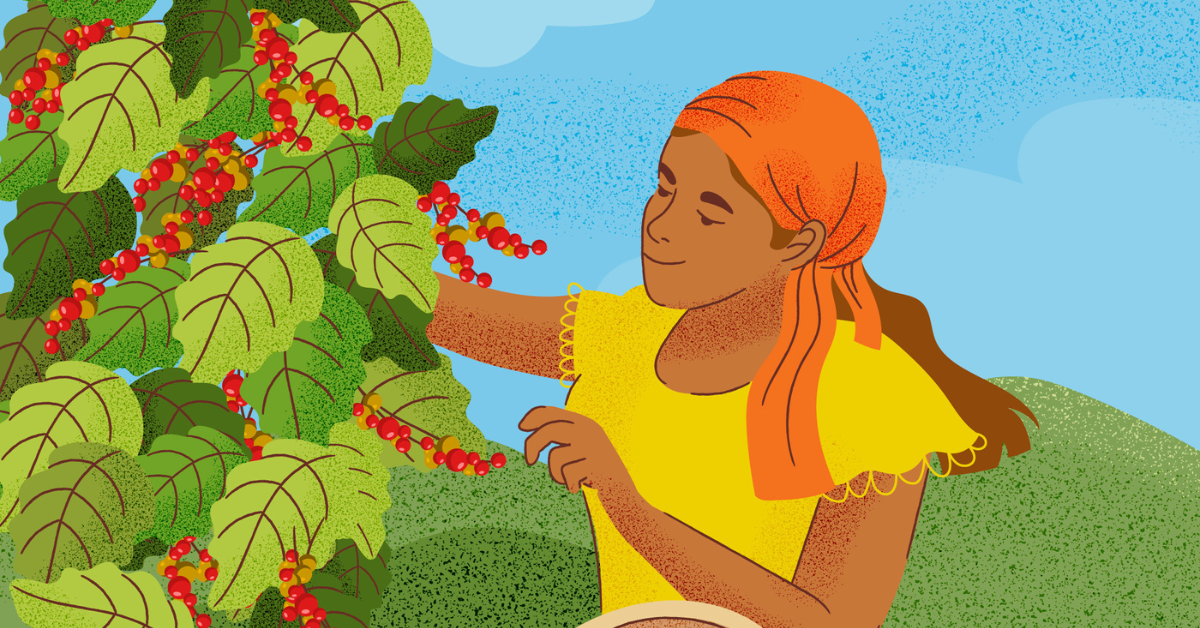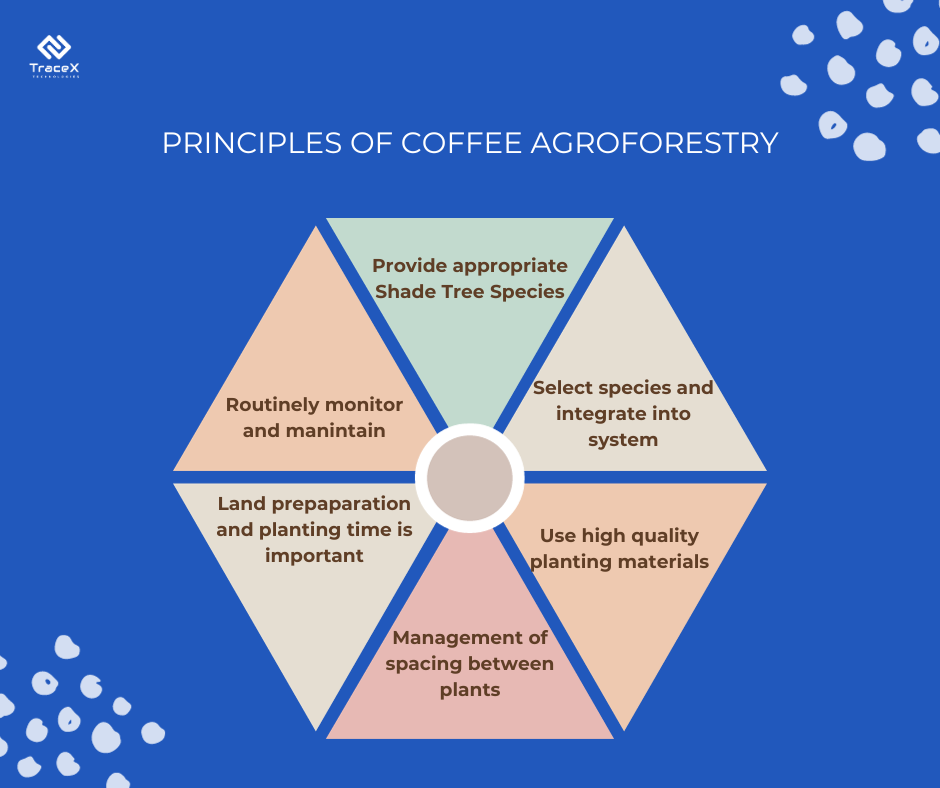Contact: +91 99725 24322 |
Menu
Menu
Quick summary: Embark on a journey through the lush landscapes of agroforestry in the coffee value chain. Uncover how this sustainable farming practice harmonizes with nature, fosters resilience, and positively impacts coffee yields. Explore the symbiotic relationship between trees and coffee plants, promoting biodiversity and mitigating climate change effects. Delve into the blog for insights into agroforestry's role in crafting a greener and more sustainable coffee industry.

Agroforestry is a sustainable land management system that integrates trees and shrubs into agricultural practices, fostering ecological and economic benefits. In the context of the coffee value chain, agroforestry plays a pivotal role. Agroforestry in the coffee value chain, enhances biodiversity, soil health, and water retention. Shade-providing trees protect coffee plants, improving yield and quality. Additionally, diverse tree species offer supplementary income through timber or fruits. Agroforestry in the coffee value chain not only boosts environmental resilience but also contributes to the socio-economic well-being of farmers, promoting a holistic and sustainable approach to coffee production.
An analysis by SEI suggests climate change could reduce global Arabica coffee production by 45.2%, and global Robusta bean production by 23.5%.
As we delve into the vibrant world of coffee cultivation, we’ll explore how the strategic integration of trees transforms not just the landscapes but also the very essence of the coffee value chain. Join us on a journey where sustainability meets flavor, and agroforestry becomes the guiding principle for a thriving, eco-conscious coffee industry.
The climate crisis is disrupting coffee production in all corners of the globe. Growing coffee is a meticulous endeavor, demanding specific climatic conditions found in the tropical coffee belt. The Arabica species, constituting 70% of global production, thrives in mean annual temperatures up to 24°C. However, escalating temperatures, erratic rainfall, and prolonged droughts pose challenges. The changing climate may render areas accustomed to coffee cultivation unsuitable by mid-century, potentially reducing suitable growing regions by up to 50% by 2050. The warming climate threatens the very conditions essential for nurturing this beloved commodity.
In the last ten years, coffee producers worldwide have witnessed consistent drops in yields, attributed to a blend of extreme weather conditions and unsustainable agricultural practices. Climate change-induced events like droughts, floods, and elevated temperatures heighten the vulnerability of coffee farming. Compounding issues such as soil erosion, pollution, and biodiversity loss exacerbate the negative impact on coffee production. Recognizing the imperative for adaptive measures, numerous coffee growers are embracing agroforestry—an approach involving the reintroduction of trees into farming systems—to enhance resilience in the face of climate change.
Agroforestry emerges as a noteworthy nature-based solution proving instrumental in bolstering resilience, increasing productivity in coffee cultivation, and mitigating the impact of climate change on the industry. This practice involves integrating trees into coffee farming systems, fostering a symbiotic relationship that enhances ecological, economic, and social resilience. By intercropping coffee plants with shade trees and complementary crops, agroforestry promotes biodiversity, attracting beneficial insects and deterring pests. The presence of shade trees acts as a natural shield against extreme weather events, reducing the risk of crop damage.
Moreover, these trees serve as potent carbon sinks, storing approximately 8.4 tonnes of carbon per hectare per year globally, contributing significantly to offsetting the carbon footprint of coffee production.
At a broader scale, agroforestry has the potential to sequester an impressive 8 billion tonnes of carbon annually, equivalent to 40% of the combined greenhouse gas emissions from the UK, Germany, France, and Canada during the 2010s.
Shade-grown coffee exemplifies a sustainable agroforestry practice where coffee plants thrive under the canopy of diverse trees. The shade not only protects the coffee crop from extreme weather conditions but also encourages a more gradual maturation of coffee cherries, resulting in improved flavor profiles. This method fosters biodiversity by creating a habitat for various species, contributing to a healthier ecosystem.
Intercropping with native trees involves cultivating coffee alongside indigenous tree species. This symbiotic relationship enhances soil fertility, reduces pest pressures, and provides additional income streams for farmers through the sale of timber or fruits. The diversified landscape promotes ecological resilience and supports the conservation of native flora and fauna.
Alley cropping and silvopasture integrate trees with agricultural activities. In alley cropping, crops are grown between rows of trees, preventing soil erosion and maximizing land use efficiency. Silvopasture combines trees, forage, and livestock, creating a sustainable and productive system that benefits both agriculture and animal husbandry.
Multi-layered agroforestry systems encompass the cultivation of different vegetation strata, such as canopy trees, understory shrubs, and ground-level crops. This approach maximizes resource use, optimizes microclimates, and enhances overall biodiversity. The synergy between layers creates a resilient and productive agroecosystem, showcasing the multifaceted benefits of thoughtful agroforestry design.

Agroforestry significantly contributes to the reduction of deforestation and habitat loss. By integrating trees into agricultural landscapes, agroforestry minimizes the need for clearing large areas of forest for agriculture. This approach helps preserve biodiversity by maintaining natural habitats and wildlife corridors, thus mitigating the negative impacts of deforestation on ecosystems.
Agroforestry plays a vital role in carbon sequestration and climate change mitigation. Trees absorb and store carbon dioxide, mitigating greenhouse gas emissions. The diverse tree species in agroforestry systems enhance carbon sequestration, contributing to climate resilience and global efforts to combat climate change.
Economic benefits for local communities arise from agroforestry practices. The integration of trees diversifies income sources for farmers through timber, fruits, and other non-timber forest products. This economic diversity improves livelihoods and reduces dependency on a single crop, enhancing the overall resilience of local communities.
Social and cultural aspects of agroforestry are integral to its success. Agroforestry practices often align with traditional knowledge and cultural practices, fostering a sense of community ownership and continuity. The connection to the land through agroforestry strengthens social bonds and sustains cultural values, creating a holistic approach to sustainable land management.
Biodiversity conservation within agroforestry systems is crucial for maintaining a resilient and balanced ecosystem.
In essence, agroforestry stands as a comprehensive and sustainable strategy, harmonizing agricultural production with environmental stewardship.
Potential challenges in implementing agroforestry in coffee farms include initial resistance to change, concerns about reduced short-term yields, and a lack of awareness about agroforestry benefits. Farmers may also face difficulties in accessing resources or technical knowledge required for successful integration.
Strategies to overcome these barriers involve farmer education programs to highlight long-term gains, financial incentives or subsidies for agroforestry adoption, and fostering community engagement. Providing technical support and showcasing successful case studies can empower farmers to embrace agroforestry, promoting sustainable practices in coffee cultivation.
In discussions surrounding sustainability in the coffee sector, transparency and traceability stand out as pivotal topics. These concepts revolve around providing access to detailed production-level information, ranging from the prices offered to coffee producers to the specific land plots where coffee is cultivated.
Over the years, technology has played a crucial role in enhancing transparency and traceability within coffee production. Blockchain technology, in particular, has been a notable example, enabling various stakeholders in the supply chain to store data on a decentralized network system.
TraceX’s traceability solutions, coupled with digital monitoring, reporting, and verification (DMRV) tools, are playing a pivotal role in facilitating the adoption of agroforestry practices within the coffee industry.
TraceX’s traceability solutions enable coffee companies to precisely track and record information related to agroforestry practices. This includes data on the types of trees planted, their locations, and the impact on coffee yields.
The traceability solutions provide transparency across the coffee supply chain. This ensures that stakeholders can access real-time information about agroforestry initiatives, fostering trust and accountability.
The DMRV tools integrated into TraceX solutions allow for real-time monitoring of the environmental impact of agroforestry. This includes tracking carbon sequestration, biodiversity enhancement, and other ecological benefits.
TraceX helps coffee companies adhere to sustainability standards and certifications related to agroforestry. The system ensures that practices align with environmental regulations, promoting responsible and compliant agroforestry.
Through comprehensive data collection and analysis, TraceX empowers coffee companies to make informed decisions about agroforestry strategies. This includes identifying areas for improvement and optimizing practices for greater sustainability.
In conclusion, agroforestry emerges as a holistic and sustainable approach with multifaceted benefits. From biodiversity conservation to climate change mitigation, its impact extends across environmental, economic, and social dimensions. Despite challenges, innovative strategies, education, and community involvement can overcome barriers, fostering widespread adoption. As we navigate the complexities of modern agriculture, agroforestry stands as a beacon, harmonizing productivity with ecological resilience. Embracing this integrated model not only secures our agricultural future but also nurtures a balanced coexistence between human activities and the natural world, epitomizing the essence of sustainable development.
